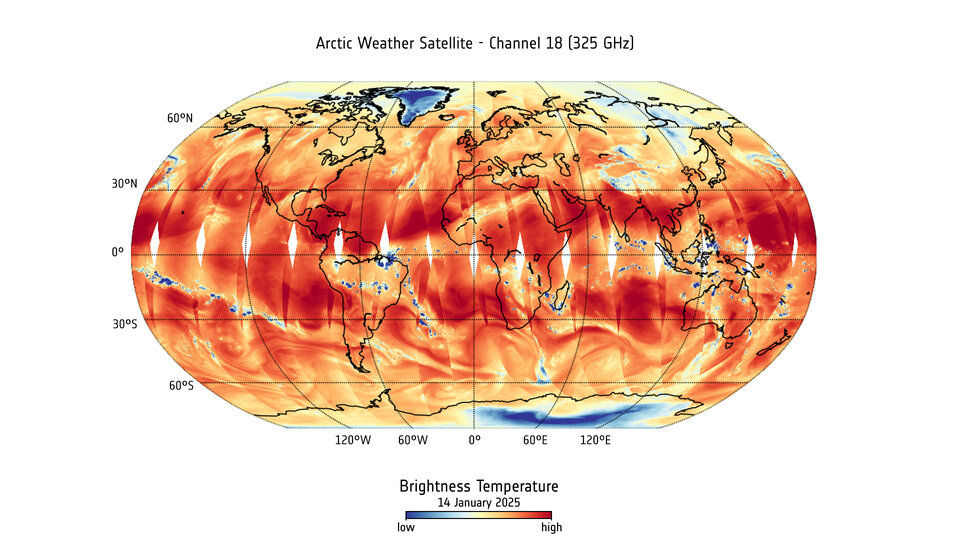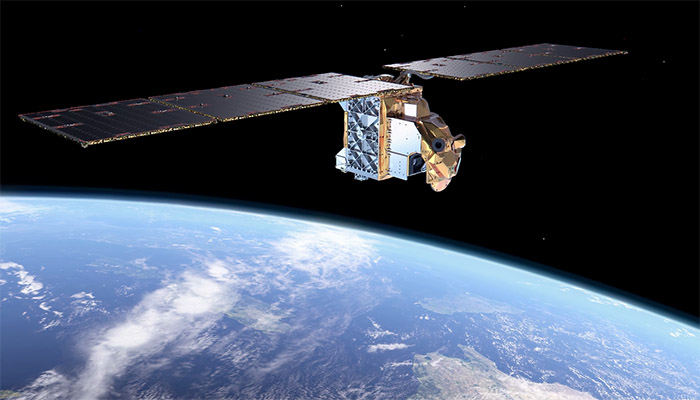ESA’s Arctic Weather Satellite has been proving how the New Space approach can accelerate the development of missions capable of delivering detailed temperature and humidity profiles for short-term weather forecasts
Moreover, the impact of this tiny prototype satellite goes even further – its measuring instrument has been recognised as able to provide data that’s on a par with traditional large missions.
Equipped with a 19-channel cross-track scanning microwave radiometer, the satellite’s mission is to penetrate the atmosphere and provide detailed temperature and humidity profiles in all weather conditions.
Despite its name, the Arctic Weather Satellite collects measurements around the globe. However, its humidity data are particularly valuable for weather forecasting across the Arctic where concentrations of water vapour can change rapidly.

The Arctic Weather Satellite, developed as a prototype within three years and for a fraction of the cost of a traditional Earth observing mission, has already demonstrated that the New Space approach of building quickly and at low cost could be applied to a future constellation of similar satellites.
But the next step is to thoroughly assess how its data can improve the accuracy of weather forecasts. This is a crucial step, providing Eumetsat and its Member States with confidence that the mission concept can be applied to the proposed EPS-Sterna follow-on constellation.
If the constellation moves forward, ESA would be responsible for building the satellites for Eumetsat, which would handle operations in orbit and data distribution – following the established model used for Europe’s other meteorological missions, namely the geostationary Meteosat and the polar-orbiting MetOp missions.
So, as part of this all-important evaluation process the data are being scrutinised by a host of European meteorological offices, including the Danish Meteorological Office, the German Weather Service, the European Centre for Medium-Range Weather Forecasts, the Finnish Meteorological Institute, Météo-France, the Norwegian Meteorological Institute, the UK Met Office, and the Swedish Meteorological and Hydrological Institute.
Eumetsat, which is responsible for distributing the data, is also evaluating the mission’s performance independently.

Although it’s early days, their feedback is extremely positive. Not only do they acknowledge that the Arctic Weather Satellite’s microwave radiometer is performing as well as other similar European, American and Chinese instruments in orbit, but that the mission’s humidity profiles are particularly impactful for weather forecasting, as the bar chart above shows.
Philippe Chambon, from Météo-France, said, “Our team has carefully evaluated the quality of the Arctic Weather Satellite’s data and has already been able to demonstrate a positive impact on our forecasts at the global scale, and we plan to include the data in our global prediction system later this year. This a very promising achievement in view of the EPS-Sterna constellation, which is seen as a key component of the future observing system.”
Niels Bormann, from the European Centre for Medium-Range Weather Forecasts, noted, “The Arctic Weather Satellite is a great example of the quality of meteorological data that can be achieved from a small satellite. Our initial results are very promising for global weather forecasts and, if they hold up, we fully expect to use the data operationally later in the year. This is excellent news for the proposed EPS-Sterna constellation of six such satellites, which would greatly improve temporal coverage globally.”

Arctic Weather Satellite channel comparison
Adam Dybbroe, from the Swedish Meteorological and Hydrological Institute, added, “Together with the Nordic national meteorological services, we are evaluating the Arctic Weather Satellite’s data for regional forecasting over Scandinavia and the Arctic. Given their good quality, we plan to integrate the data into our operational forecast model later this year, and we are expecting measurable improvements. This bodes well for the EPS-Sterna mission.”
The Arctic Weather Satellite also introduces significant innovation. Its microwave radiometer includes a groundbreaking 325 GHz sounding channel, a frequency never before used for operational weather prediction. The images above indicate the added value of this channel.
Assessments also confirm its potential for new cloud-ice measurements that would also bring benefits to weather forecast accuracy.
ESA’s Arctic Weather Satellite Project Manager, Ville Kangas, concluded, “We have demonstrated that a small satellite, weighing just 125 kg, can match the performance of large meteorological missions. And since we are at a relatively early stage, the data still need to be further corrected and analysed so we expect the Arctic Weather Satellite to shine even more in the months to come.”
If the EPS-Sterna constellation becomes a reality it would complement the Meteosat Third Generation mission and the MetOp Second Generation weather missions. The next MTG satellite, MTG-S1, and the first MetOp-SG, MetOp-SG-A1, are scheduled to be launched this summer.
The Meteosat geostationary satellites positioned 36 000 km above the equator return images every 15 minutes, but they have no visibility of higher latitudes, closer to the poles, so cannot be used for Arctic weather forecasting. The MetOp satellites do return data over the poles as they circle Earth from pole to pole in a lower orbit, but it can take up to 24 hours to achieve global coverage. The EPS-Sterna constellation of six satellites would fill the temporal coverage gap









Be the first to comment on "ESA’s Arctic Weather Satellite"